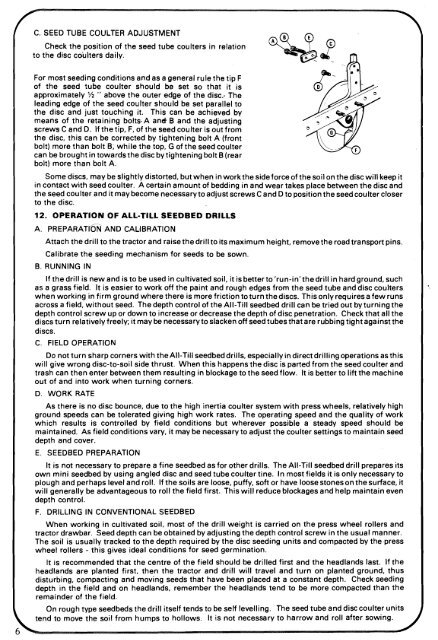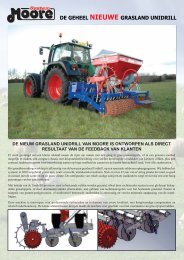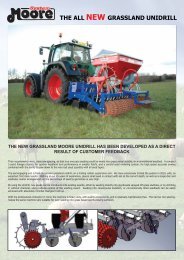7400 - 7509.pdf - Moore Unidrill
7400 - 7509.pdf - Moore Unidrill
7400 - 7509.pdf - Moore Unidrill
Create successful ePaper yourself
Turn your PDF publications into a flip-book with our unique Google optimized e-Paper software.
C. SEED TLlBE COLILTER ADJUSTMENT<br />
Check the position of the seed tube coulters in relation<br />
to the disc coulters daily.<br />
For most seeding conditions and as a general rule the tip F<br />
of the seed tube coulter should be set so that it is<br />
approximately l/z " above the outer edge of the disc.. The<br />
leading edge of the seed coulter should be set parallel to<br />
the disc and just touching it. This can be achieved by<br />
means of the retaining bolts-A an& B and the adjusting<br />
screws C and D. If the tip, F, of the seed coulter is out from<br />
the disc, this can be corrected by tightening bolt A (front<br />
bolt) more than bolt B, while the top, G of the seed coulter<br />
can be brought in towards the disc by tightening bolt B (rear<br />
bolt) more than bolt A.<br />
Some discs, may be slightly distorted, but when in workthe side force of the soil on the disc will keep it<br />
in contact with seed coulter. A certain amount of bedding in and wear takes place between the disc and<br />
the seed coulter and it may become necessary to adjust screws C and D to position the seedcoulter closer<br />
to the disc.<br />
12. OPERATION OF ALL-TILL SEEDBED DRILLS<br />
A. PREPARATION AND CALIBRATION<br />
Attach the drill to the tractor and raise thedrill to its maximum height, removethe road transport pins.<br />
Calibrate the seeding mechanism for seeds to be sown.<br />
B. RUNNING IN<br />
If thedrill is new and is to be used in cultivated soil, it is betterto'run-in'thedrill in hard ground, such<br />
as a grass field. It is easier to work off the paint and rough edges from the seed tube and disc coulters<br />
when working in firm ground where there is more friction toturn thediscs. 'This only requires a few runs<br />
across a field, without seed. The depth control of the All-Till seedbed drill can be tried out by turning the<br />
depth control screw up or down to increase or decrease the depth of disc penetration. Check that all the<br />
discs turn relatively freely; it may be necessary to slacken off seed tubes that are rubbing tight against the<br />
discs.<br />
C. FIELD OPERATION<br />
Do not turn sharp corners with the All-Till seedbed drills, especially in direct drilling operations asthis<br />
will give wrong disc-to-soil side thrust. When this happens the disc is parted from the seed coulter and<br />
trash can then enter between them resulting in blockage to the seed flow. It is better to lift the machine<br />
out of and into work when turning corners.<br />
D. WORK RATE<br />
As there is no disc bounce, due to the high inertia coulter system with press wheels, relatively high<br />
ground speeds can be tolerated giving high work rates. 'The operating speed and the quality of work<br />
which results is controlled by field conditions but wherever possible a steady speed should be<br />
maintained. As field conditions vary, it may be necessary to adjust the coulter settings to maintain seed<br />
depth and cover.<br />
E. SEEDBED PREPARATION<br />
It is not necessary to prepare a fine seedbed as for other drills. The All-Till seedbed drill prepares its<br />
own mini seedbed by using angled disc and seed tube coulter tine. In most fields it is only necessary to<br />
plough and perhaps level and roll. If the soils are loose, puffy, soft or have loosestoneson thesurface, it<br />
will generally be advantageous to roll the field first. This will reduce blockages and help maintain even<br />
depth control.<br />
F. DRILLING IN CONVENTIONAL SEEDBED<br />
When working in cultivated soil, most of the drill weight is carried on the press wheel rollers and<br />
tractor drawbar. Seed depth can be obtained by adjusting the depth control screw in the usual manner.<br />
The soil is usually tracked to the depth required by the disc seeding units and compacted by the press<br />
wheel rollers - this gives ideal conditions for seed germination.<br />
It is recommended that the centre of the field should be drilled first and the headlands last. If the<br />
headlands are planted first, then the tractor and drill will travel and turn on planted ground, thus<br />
disturbing, compacting and moving seeds that have been placed at a constant depth. Check seeding<br />
depth in the field and on headlands, remember the headlands tend to be more compacted than the<br />
remainder of the field.<br />
On rough type seedbeds the drill itself tends to be self levelling. The seed tube and disccoulter units<br />
tend to move the soil from humps to hollows. It is not necessary to harrow and roll after sowing.






